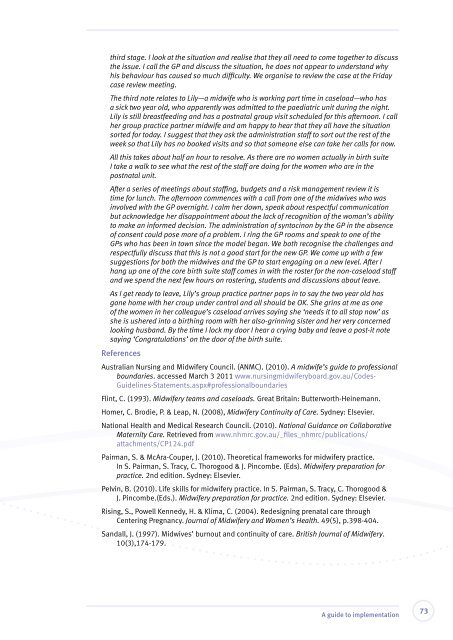Delivering continuity of midwifery care to Queensland women
Delivering continuity of midwifery care to Queensland women
Delivering continuity of midwifery care to Queensland women
Create successful ePaper yourself
Turn your PDF publications into a flip-book with our unique Google optimized e-Paper software.
third stage. I look at the situation and realise that they all need <strong>to</strong> come <strong>to</strong>gether <strong>to</strong> discuss<br />
the issue. I call the GP and discuss the situation, he does not appear <strong>to</strong> understand why<br />
his behaviour has caused so much difficulty. We organise <strong>to</strong> review the case at the Friday<br />
case review meeting.<br />
The third note relates <strong>to</strong> Lily—a midwife who is working part time in caseload—who has<br />
a sick two year old, who apparently was admitted <strong>to</strong> the paediatric unit during the night.<br />
Lily is still breastfeeding and has a postnatal group visit scheduled for this afternoon. I call<br />
her group practice partner midwife and am happy <strong>to</strong> hear that they all have the situation<br />
sorted for <strong>to</strong>day. I suggest that they ask the administration staff <strong>to</strong> sort out the rest <strong>of</strong> the<br />
week so that Lily has no booked visits and so that someone else can take her calls for now.<br />
All this takes about half an hour <strong>to</strong> resolve. As there are no <strong>women</strong> actually in birth suite<br />
I take a walk <strong>to</strong> see what the rest <strong>of</strong> the staff are doing for the <strong>women</strong> who are in the<br />
postnatal unit.<br />
After a series <strong>of</strong> meetings about staffing, budgets and a risk management review it is<br />
time for lunch. The afternoon commences with a call from one <strong>of</strong> the midwives who was<br />
involved with the GP overnight. I calm her down, speak about respectful communication<br />
but acknowledge her disappointment about the lack <strong>of</strong> recognition <strong>of</strong> the woman’s ability<br />
<strong>to</strong> make an informed decision. The administration <strong>of</strong> syn<strong>to</strong>cinon by the GP in the absence<br />
<strong>of</strong> consent could pose more <strong>of</strong> a problem. I ring the GP rooms and speak <strong>to</strong> one <strong>of</strong> the<br />
GPs who has been in <strong>to</strong>wn since the model began. We both recognise the challenges and<br />
respectfully discuss that this is not a good start for the new GP. We come up with a few<br />
suggestions for both the midwives and the GP <strong>to</strong> start engaging on a new level. After I<br />
hang up one <strong>of</strong> the core birth suite staff comes in with the roster for the non-caseload staff<br />
and we spend the next few hours on rostering, students and discussions about leave.<br />
As I get ready <strong>to</strong> leave, Lily’s group practice partner pops in <strong>to</strong> say the two year old has<br />
gone home with her croup under control and all should be OK. She grins at me as one<br />
<strong>of</strong> the <strong>women</strong> in her colleague’s caseload arrives saying she ‘needs it <strong>to</strong> all s<strong>to</strong>p now’ as<br />
she is ushered in<strong>to</strong> a birthing room with her also-grinning sister and her very concerned<br />
looking husband. By the time I lock my door I hear a crying baby and leave a post-it note<br />
saying ‘Congratulations’ on the door <strong>of</strong> the birth suite.<br />
References<br />
Australian Nursing and Midwifery Council. (ANMC). (2010). A midwife’s guide <strong>to</strong> pr<strong>of</strong>essional<br />
boundaries. accessed March 3 2011 www.nursing<strong>midwifery</strong>board.gov.au/Codes-<br />
Guidelines-Statements.aspx#pr<strong>of</strong>essionalboundaries<br />
Flint, C. (1993). Midwifery teams and caseloads. Great Britain: Butterworth-Heinemann.<br />
Homer, C. Brodie, P. & Leap, N. (2008), Midwifery Continuity <strong>of</strong> Care. Sydney: Elsevier.<br />
National Health and Medical Research Council. (2010). National Guidance on Collaborative<br />
Maternity Care. Retrieved from www.nhmrc.gov.au/_files_nhmrc/publications/<br />
attachments/CP124.pdf<br />
Pairman, S. & McAra-Couper, J. (2010). Theoretical frameworks for <strong>midwifery</strong> practice.<br />
In S. Pairman, S. Tracy, C. Thorogood & J. Pincombe. (Eds). Midwifery preparation for<br />
practice. 2nd edition. Sydney: Elsevier.<br />
Pelvin, B. (2010). Life skills for <strong>midwifery</strong> practice. In S. Pairman, S. Tracy, C. Thorogood &<br />
J. Pincombe.(Eds.). Midwifery preparation for practice. 2nd edition. Sydney: Elsevier.<br />
Rising, S., Powell Kennedy, H. & Klima, C. (2004). Redesigning prenatal <strong>care</strong> through<br />
Centering Pregnancy. Journal <strong>of</strong> Midwifery and Women’s Health. 49(5), p.398-404.<br />
Sandall, J. (1997). Midwives’ burnout and <strong>continuity</strong> <strong>of</strong> <strong>care</strong>. British Journal <strong>of</strong> Midwifery.<br />
10(3),174-179.<br />
A guide <strong>to</strong> implementation<br />
73
















